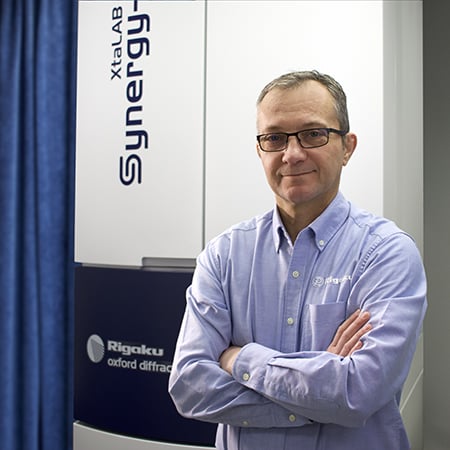HyPix-Arc 100°
Curved Photon Counting X-ray Detector
Curved X-ray detector
The HyPix-Arc 100° is a curved Hybrid Photon Counting (HPC) X-ray detector for single crystal diffraction applications. HyPix-Arc 100° offers a 17° larger capture angle compared to the flat HyPix 6000 detector. Collect more data in a single exposure with less reflection profile distortion:

HyPix-Arc 100° Overview
The HyPix-Arc 100° offers 100 degrees angular coverage from edge to edge. This is more than enough to collect complete single crystal diffraction data, according to IUCr guidelines, for even Cu Kα X-ray wavelength from a single theta position. High and low angle data are measured at the same time, under the same conditions for better scaling, faster data and reduced dose time. A curved detector minimizes peak distortion by ensuring that, even at short crystal-to-detector distances, diffracted beams are closer to perpendicular than is possible with a flat geometry.
Like all HPC detectors, the HyPix-Arc 100° offers direct X-ray photon counting for every photon, single pixel top-hat point spread function with no readout noise and no dark noise. The 100 micron pixel size allows better resolution of reflections for long unit cells as well as improving reflection profile analysis. The HyPix-Arc 100° has a high frame rate of 100 Hz, as well as a Zero Dead Time mode providing the ultimate in error-free shutterless data collection.
The advantage of direct detection found in the HyPix-Arc 100° is that no scintillator is required, and the size of the pixel determines the point spread function rather than the blooming that occurs on detectors with a scintillator. This means that reflections are sharper and more easily resolved. Profile analysis will not require incorporating additional pixels to compensate for scintillator blooming leading to less experimental noise, such as air scatter, being incorporated into a reflection. As opposed to monolithic detectors, such as CMOS-based CPADs, a hybrid detector separates the detection area from the read-out electronics. This means that the full area of a pixel is sensitive to incoming X-ray photons, with the charge being transmitted through an indium bump bond to a secondary readout pixel. In APS-CMOS/CPAD detectors, each pixel contains in-pixel readout electronics that come at the expense of light sensitive area. Monolithic detectors used in crystallography often have a 30% dead area or detection-gap per pixel that occurs through the whole detector.
The HyPix-Arc 100° is the perfect detector for measuring diffraction from small and poorly diffracting samples due to the extremely low noise characteristics: you can count as long as you need to without the dark current or noise build up seen in other detectors. When your crystals diffract well, the high frame rate and Zero Dead Time mode mean that you can collect data extremely fast and accurately in a shutterless mode.
HyPix-Arc 100° Features
HyPix-Arc 100° Videos
HyPix-Arc 100° Specifications
| Technique | Single crystal X-ray diffraction | |
|---|---|---|
| Benefit | Curved photon counting detector | |
| Technology | Hybrid Photon Counting (HPC) X-ray detector | |
| Attributes | Water cooled, curved HPC detector | |
| Computer | External PC, MS Windows® OS, CrysAlisPro | |
| Dimensions | 193 (W) x 144 (H) x 254 (D) (mm) | |
| Mass | 8 kg approx. (core unit) | |
| Power requirements | 1Ø, 100-240 V, 15 A | |
HyPix-Arc 100° Application Notes
The following application notes are relevant to this product
-
SMX038 - Rigaku Rotating Anodes: Powerful and Reliable Sources for Seamless and High-throughput Small Molecule Structure Solution
-
SMX024 - Charge-density Data Collection on XtaLAB Synergy Diffractometers
HyPix-Arc 100° Events
Learn more about our products at these events
-
EventDatesLocationEvent website
-
Rigaku School for Practical CrystallographyJanuary 26 2026 - February 6 2026
-
34th Annual Meeting of the German Crystallographic Society (DGK)February 25 2026 - February 28 2026Lübeck, Germany
-
Pittcon 2026March 9 2026 - March 11 2026San Antonio, TX, USA
-
BCA Spring Meeting 2026March 30 2026 - April 1 2026Leeds, United Kingdom
-
27th Congress and General Assembly of the IUCrAugust 11 2026 - August 18 2026Calgary, Alberta, Canada
HyPix-Arc 100°

Contact Us
Whether you're interested in getting a quote, want a demo, need technical support, or simply have a question, we're here to help.
